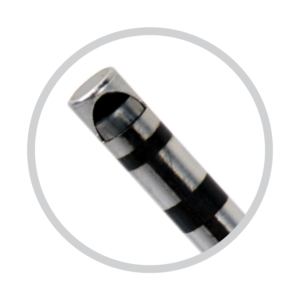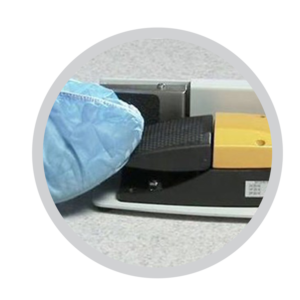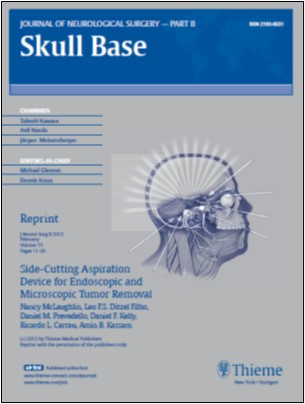What is the incidence in the United States of common lesions resected via a transnasal approach?
Pituitary Adenomas
12,950 average new cases diagnosed per year1
5-13.5% (648-1,748) are fibrous and tough2
Craniopharyngiomas
603 average new cases diagnosed per year1
Chordomas
50 average new cases diagnosed per year3
Meningiomas
29,183 average new cases diagnosed per year1
Germ Cell Tumors and Cysts
297 average new cases diagnosed per year1

What challenges have been encountered with conventional surgical approaches?
- Tumors Removed via a Transnasal Approach WITHOUT automation
- Hard to achieve gross total resection (GTR)4
- Higher morbidity5
- Increased operating times and operative fatigue2
- Tumors Removed via a Transnasal Approach using an Ultrasonic Aspirator
- Morphological damage4,6
- Limited visualization7
- Fragmented tissue is destroyed and rendered unable to be used for pathological examination and/or tissue harvesting
How does the NICO Myriad NOVUS with a transnasal approach overcome some of the challenges of conventional approaches?
- Ability to safely and quickly internally debulk the tumor and facilitate capsular dissection2
- Essential to obtain a complete resection in a reasonable time period for many cases7
- Bendable design of the Myriad NOVUS allows for the tip to advance to the third ventricle which is extremely useful for removing tumor fragments in the suprasellar cistern that may be beyond reach of angled suctions7
- Effective for tumors that are too firm for bimanual suction or ring curette dissection7
- Automated, linear, variable aspiration controlled by the surgeon can reduce nerve manipulation and dissection caused by manual instrumentation
- Mechanically allows for microdissection of tissues in order to avoid effects of unnecessary pulling and tugging with ring curette and forceps
- End of device is closed and blunt so there is little danger of injuring vessels or other fragile structures obscured from view by the instrument itself7



- Multifunctional design affords controlled tissue shaving, gross tissue debulking and safe microdissection with the same instrument which allows for minimal instrument exchange4
- Eliminates need for French size suction exchange during the procedure
- Potentially decrease operating time and operative fatigue due to automation8
- Lightweight design requires the use of only one hand for safe handling while avoiding conflict between surgeon’s hands, endoscope and other instruments within same nostril7
- Quick set-up
- Ability to place the aperture on the tumor capsule with the cutting side inwards and the noncutting side on a neurovascular structure to safely remove the remainder of tumor7
- Ability to shave tumor off the diaphragma sellae without tearing the diaphragma2
- Lack of thermal heat energy is particularly useful when working along the skull base in close proximity to neurovascular structures or in highly scarred-in and adherent tissue4
![]()
- Automated variable aspiration controlled by the surgeon with direct visualization of suction aperture and tissue being resected2
- Ability to maneuver through narrow corridors while providing direct visualization of the suction aperture during tumor resection4
- All tissue is captured when the Myriad NOVUS is used in conjunction with a specimen collector with filter element. There is no loss to the suction canister
- Collection of aspirated tissue with minimal crush artifact is an advantage for tumor tissue analysis2
- Ability to infuse/perfuse tissue creates the desired biological environment, which may aid tissue hydration
- Enables the ability to capture and annotate tissue with correlation to specific intratumoral location for potential further advancement in personalized medicine9
Key Publications
Weill Cornell Medical College, New York Presbyterian Hospital in Neurosurgery Focus (2011)7 – Use of a side-cutting aspiration device for resection of tumors during endoscopic endonasal approaches
University of Iowa Publication in Neurosurgical Focus (2011)2 – Emerging technology in intracranial neuroendoscopy: application of the NICO Myriad
Citations
- Quinn T Ostrom, Haley Gittleman, Gabrielle Truitt, Alexander Boscia, Carol Kruchko, Jill S Barnholtz-Sloan, CBTRUS Statistical Report: Primary Brain and Other Central Nervous System Tumors Diagnosed in the United States in 2011–2015, Neuro-Oncology, Volume 20, Issue suppl_4, October 2018, Pages iv1–iv86, https://doi.org/10.1093/neuonc/noy131
- Dlouhy BJ, Dahdaleh NS, Greenlee JDW. Emerging technology in intracranial neuroendoscopy: application of the NICO Myriad. Neurosurg Focus. 2011; 30(4):E6. https://thejns.org/focus/view/journals/neurosurg-focus/30/4/article-pE6.xml
- http://www.cbtrus.org/www.cbtrus.org/reports/reports.html
- McLaughlin N, Filho LFSD, Prevedello DM, Kelly DF, Carrau RL, Kassam AB. Side-cutting aspiration device for endoscopic and microscopic tumor removal. J Neurol Surg B. 2013; 73:11-20. https://dx.doi.org/10.1055/s-0032-1304834
- Kassam A, Corsten M, Rovin R. Chapter 19: The expanded endonasal approach to skull base meningiomas. P. Cappabianca et al. (eds.), Midline Skull Base Surgery. 2016; 215-221. https://dx.doi.org/10.1007/978-3-319-21533-4_19
- G.J. Ledderose, N. Thon, W. Rachinger, et al., Use of an ultrasonic aspirator in transnasal surgery of tumorous lesions of the anterior skull base, Interdisciplinary Neurosurgery: Advanced Techniques and Case Management(2019), https://doi.org/10.1016/j.inat.2019.100545
- Garcia-Navarro V, Lancman G, Guerrero-Maldonado A, Anand VK, Schwartz TH. Use of a side-cutting aspiration device for resection of tumors during endoscopic endonasal approaches. Neurosurg Focus. 2011; 30(4):E13. https://dx.doi.org/10.3171/2011.1.FOCUS10302
- Mohanty A, Thompson BJ, Patterson J. Initial experience with endoscopic side cutting aspiration system in pure neuroendoscopic excision of large intraventricular tumors. World Neurosurgery. 2013; 80(5): 655 e.15-655 e.21. https://dx.doi.org/10.1016/j.wneu.2012.11.070
- Chen, Y et al. Acta Neurochirugica. 2017; DOI: 10.1007/s00701-017-3260-7
